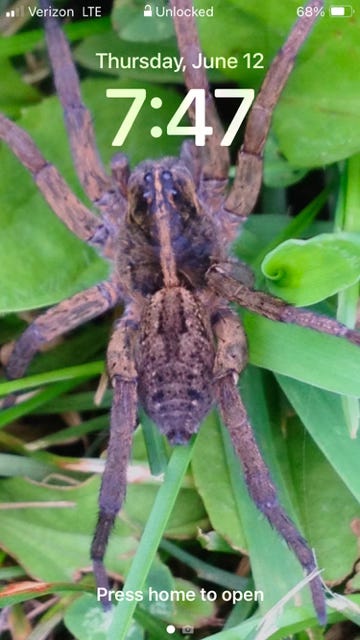“There was a big spider in my room. I killed it. Is that okay?” The woman asking is a sweet and mild person, a guest at our yoga retreat. She’s not complaining, she’s seeking absolution. And I am an avowed spider-rescuer. I stammer my reply, trying to be kind. But since she asked (“Is that okay?”), I mention that I don’t kill spiders, while reassuring her, a guest from a foreign country who’d encountered a big black spider in her room, that it is okay.
Later that day, while exchanging phone numbers, she catches a glimpse of my phone, and her hand flies to her mouth in horror. I look down and see the picture of a large spider decorating the screen. She isn’t horrified by the picture - she is horrified she killed that spider. She apologizes again. I reassure her again. When we say an affectionate good-bye the next day, she tells me earnestly she will never kill a spider again.
I don’t think I’m quite an arachnophile - I don’t want a tarantula for a pet, and I don’t even know what type of spider it is that graces my phone wallpaper. But I have great admiration for spiders, and go out of my way not to harm them. I patiently tolerate the spindly house spiders who occupy all the corners of my home, and even occasionally drop a ladybug (the invasive, overabundant type) into a web. Other spiders I trap under a glass, slide a piece of paper underneath, and transport outdoors. Last summer an amazing orb spider occupied a window in my study, and her intricate web, and the carnage it reaped on passing bugs, was clearly on display, and witnessed with fascination. When fall came, and it was time to lower the storm window, my son and I carefully transported her to a window in the barn. I don’t know how it worked out - I never saw her again. Nor do I know a spider’s lifespan, or how they spend the winter.
Working in the garden in springtime spotlights the many things I don’t know, and an unending series of small decisions forces me constantly to confront the ideal of doing no harm. When I disturb a spider carrying a large white egg sac, I gently steer her to an adjacent row and wish her well. But when I uncover a cutworm, I am as ruthless with the caterpillar as it would be with my seedling… I break it in two. And then I wonder if birds will eat a dead caterpillar. I can’t remember how many thousands of caterpillars a bird needs to raise its young, but it’s a staggering number. Slugs and snails I toss over the fence, but now that I’ve admitted it, and googled to see if it hurts them (of course it does), I may need to think of a better method for getting them out of the garden.
Awareness of small beings makes me feel like a bumbling giant, wreaking havoc as I plant the garden, mow the lawn, clean the house. What happens to the ant, a creature who is more a member of a colony than an individual, when it stumbles into my home, only to be put out a random window? Am I saving it or dooming it? Now that I’m conscious of the insect apocalypse, I even shoo flies out rather than swat them. For ticks I have no mercy, though - they die smothered in a piece of tape, so I’m sure they don’t escape. As I make these life and death decisions, I am aware of my fallibility, my ignorance of the fine details, my lack of understanding of the big picture.
The teaching is clear: violence, whether done by oneself, causing or approving of it, or turning a blind eye, and whether preceded by greed, anger, or delusion, results in unending sorrow and ignorance (Yoga Sutra 2.34). The sutra counsels that we should therefore cultivate the opposite attitude, one of caring and responsibility. This brings a little softness to the pronouncement. Always in yoga, there is something we can do. In this case, maybe freeing a bee from the hell of a hot car, or not squishing a spider, yields a little less sorrow and ignorance in the world, and not just for the small life spared.





Excellent. Thank you.
PS I’m a bug saver too and ask those same questions every time I do. Same with snakes and worms.